An official website of the United States government
 United States Department of Labor
United States Department of Labor
| November 2014
Changes to the federal hiring process have made it easier than in the past to apply for federal jobs. But getting a job in the federal government can still be challenging. You might have to sort through dozens of vacancies to find a job that matches your qualifications, for example. Understanding how to find and apply for vacancies can help you focus your search.
This article covers the federal hiring process. The first section gives an overview of how to find vacancies for federal jobs. The second section explains how to interpret these vacancy announcements. The third section discusses how to master the application process, and the fourth section describes the final steps. Resources for more information are listed at the end of the article.
This is the second of two articles about working for the federal government. The first article, published in September, covers frequently asked questions about working for the government, employment details, and the rewards and challenges of federal work.
The federal government offers employment opportunities in a wide range of occupations, agencies, and locations. With so many choices, you may have trouble identifying the vacancies that fit your skills and interests.
The following steps provide an overview of how to find vacancies at USAJOBS.gov, the U.S. government’s job portal, and identify your options for applying. (You can also find vacancies through the general search option on the USAJOBS homepage.)
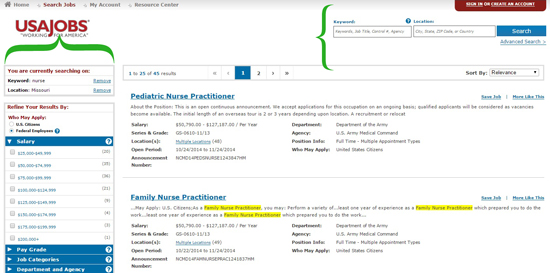
You may begin the application right away or save the vacancy announcement for later. To make the most of your time in applying for jobs, however, it’s a good idea to fully understand what a vacancy announcement is telling you about the position.
Most openings for federal jobs are advertised through a vacancy announcement at USAJOBS. The announcement describes the position and its duties, along with the requirements for applying.
For some people, making sense of the announcement is the first obstacle to applying. For example, announcements use terms, such as job series and grade, with which you may not be familiar. Learning how to read these announcements can help you target the jobs that interest you most.
Vacancy announcements are divided into five different sections, which are represented by five tabs at the top of the webpage. The first tab, titled “Overview,” shows the job title, hiring agency, and job announcement number.
The Overview includes other important information, such as salary range, promotion potential, and duty location.
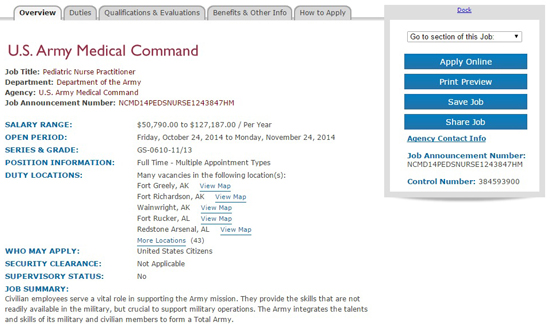
Salary range. This indicates the lowest and highest salary the position offers. Entry-level applicants usually start at the low end of this range. Applicants who have more education or experience than the position requires may negotiate for a higher starting salary, but the hiring agency is under no obligation to hire above the advertised starting salary.
Open period. The open period, which varies by agency, gives the dates during which applications are accepted. Some announcements have a “continuous” open period. This allows the hiring agency to keep applicants in a candidate pool for future vacancies.
Series and grade. The federal government classifies each job type with a 4-digit occupational series number that groups similar positions together. The grade shows the pay system and level for a position.
For example, a vacancy announcement with a series and grade listed as “GS-1515-11/12” means that the position uses the General Schedule (GS) pay system, belongs to the 1515 occupational series (jobs in the field of operations research), and starts at the GS-11 or GS-12 level (meaning a salary starting at $50,790 or $60,877, respectively, in 2014).
Position information. This field shows the position’s work schedule. Most of the time, the work schedule is full time. But some jobs have part-time, seasonal, or intermittent schedules. Announcements for part-time positions often specify the number of hours per pay period; intermittent schedules vary.
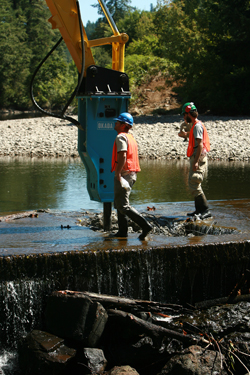
The position information also shows the type of appointment. The most common is a permanent appointment, which lasts indefinitely. With career-conditional appointments, workers may be eligible for permanent appointment after 3 years of continuous service. Temporary appointments generally last up to 1 year, but agencies can extend them for up to 2 more years if needed.
Some announcements specify whether a vacancy is in the competitive or excepted service. Vacancies in the competitive service follow the hiring guidelines from the U.S. Office of Personnel Management (OPM). Vacancies in the excepted service, which include the Central Intelligence Agency and the Federal Reserve System, set their own procedures. (See box.)
Promotion potential. This indicates the highest grade level for the position. Agencies may promote up to this level if a worker meets the requirements to advance.
Some positions have no promotion potential to a higher grade level. To advance, workers must apply to a different job at a higher grade level and compete with other applicants for that position.
Duty locations. This field states how many vacancies are available and where they are located geographically. Announcements may have one or more vacancies in a specific city or several vacancies throughout the listed locations.
Who may apply. Federal agencies consider only those applicants who meet this section’s description. The federal government identifies applicant eligibility categories; almost all federal jobs require U.S. citizenship, for example.
Agencies can set additional eligibility requirements. For example, an announcement might specify that applicants must already be federal workers or have special status, such as veterans’ preference.
Security clearance. All federal workers must pass a background check, regardless of whether they will have access to sensitive information. The background check investigates issues related to crime, drug abuse, and more.
Some positions, especially those in the excepted service, require a secret or top-secret security clearance. These clearances take months of investigation, but the scope varies. For example, a position handling money might require a look at financial records; a position dealing with classified documents might focus on travel and residential history.
Supervisory status. This indicates whether a position involves managing people and overseeing others’ work. In the GS system, supervisory positions usually start at higher grade levels than nonsupervisory jobs.
Job summary. This section gives an overview of the hiring agency or office and the position’s role within it. The description may include additional information, such as key requirements and the amount of travel involved.
The details of the job make up the bulk of each vacancy announcement. Tabs for duties, qualifications and evaluations, benefits and other info, and how to apply allow you to jump to those topics in the announcement.
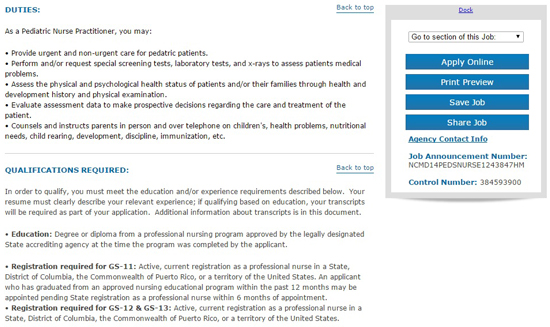
Duties. The position’s main tasks are summarized here, often in a bulleted list. The description of these duties gives you a sense of what is expected on the job. Duties vary by position.
Qualifications. The qualifications section describes the minimum level of education and work experience required for each of the position’s available grade levels, as well as the knowledge, skills, and abilities the hiring agency prefers that applicants have. Generally, you may qualify with education, experience, or a combination of both. Higher grade levels may require specialized knowledge, such as an advanced degree or related experience at a lower grade level.
In addition, this section explains how hiring agencies evaluate your application. For example, agencies may consider your résumé, referrals, and answers to application questions—all of which help show how you’re qualified for the job.
Benefits and other information. An overview of employee benefits and a link to more information appear here. Additional information on federal regulations and the hiring process is also provided. The information may discuss relocation expenses, reasonable accommodations for people with disabilities, and conditions of employment—such as registration with the Selective Service System.
How to apply. This section explains how to apply to the position, including which documents are required, whom to contact for help, and what to expect after applying. This section often includes a link to the hiring agency’s application system, which is separate from USAJOBS.
Required documents usually include a résumé and school transcripts. Some applicants, such as current federal employees and those claiming hiring preference, also must submit other records.
The federal government has streamlined the application process on USAJOBS in an attempt to reduce the time burden on applicants. But be patient: The entire hiring process may still take several months.
Before beginning your application, you must create a USAJOBS account. The registration process is easy.
From within your account, you can save documents and information, which helps you to automate parts of the application process, including your profile, résumé, job searches, and documents.
Profile. Complete your profile. This includes your contact information, hiring eligibility, employment preferences, and account information. You can also set or change your notification settings. For example, you may select to be alerted when there are changes to your application status or when a vacancy nears its closing date.
Résumé. Build a new résumé or upload an existing one to have USAJOBS automatically include that information into the résumé builder. The résumé builder requires detailed information about your work experience, education, references, and more. You may create up to five résumés for different job applications and edit them at any time.
Saved searches. This tool lets you save up to 10 job searches so you don’t have to repeat them every time you visit. As you would normally, complete the search criteria, such as keywords, salary, and location. Then, name your saved search and choose how often you want USAJOBS to email you a list of the vacancy announcements that match your criteria.
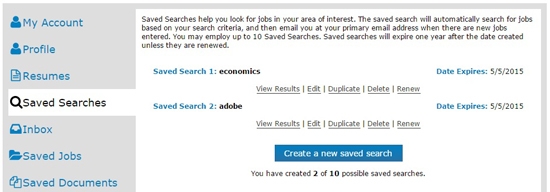
Saved documents. You may upload and save up to 10 documents. Common documents include cover letters, transcripts, and forms proving hiring eligibility. Enter a name for the document, select the document type, choose the file, and click on the upload button.
Most federal applications today include questionnaires, and some require short essays. And on USAJOBS, parts of the application are automated, such as completing repeat entries of your personal information.
Questionnaires. Questionnaires vary in length, often including true-or-false and multiple-choice questions. These questions assess your qualifications in a position’s primary duties. For example, a vacancy for an administrative assistant may ask you to select your level of experience maintaining databases, editing clerical reports, and making travel arrangements.
Be sure to carefully read the directions for each question. Some questions require you to choose more than one answer.
Short essays. Short essays allow you to use real-life examples to support the skills and knowledge you cite having. Describe a challenging problem you faced, the steps you took to solve it, and the outcome of your actions. For example, you may discuss how, as a budget analyst, you used cost-benefit analysis to prepare estimates and develop an alternative that satisfies government regulations.
In composing your essays for a federal application, follow the same rules of writing that you would for any job: Use plain language that is grammatically correct. Include keywords from the announcement whenever possible. And remember to proofread your essays—or, better yet, have someone else review them for you.
Along with submitting your application for a particular vacancy announcement, you must provide any supporting documents required in the announcement. Examples include your résumé, cover letter, and school transcripts.
Résumé and cover letter. A résumé and cover letter should detail your education and experience, if any. You can adapt your résumé and cover letter to each vacancy for which you apply.
As mentioned previously, USAJOBS allows you to upload your résumé or complete an online résumé template. Because the template for multiple jobs is so easy to use, you may be tempted not to tailor your résumé to each job for which you apply. But customizing your résumé to a particular job, such as by highlighting your skills from most to least relevant and using keywords from the vacancy announcement, helps hiring officials connect the position’s duties to your qualifications.
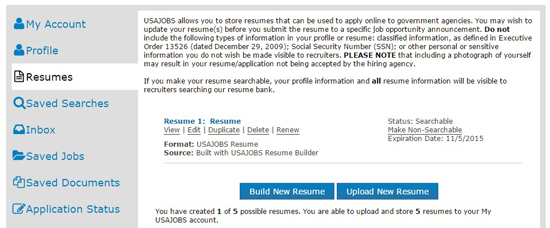
Every time you submit a résumé, you should consider including a cover letter. A cover letter serves as an introduction that shows your professionalism, explains your interest in the job, and matches your qualifications to the employer’s needs. And just as with a résumé, the cover letter should be tailored specifically to each job.
When accompanying an application for federal jobs, your résumé may expand from the single page recommended in the private sector to as many as 3 or 4 pages. Cover letters should not exceed 1 page.
Transcripts. Vacancy announcements require school transcripts whenever you cite education to qualify for a position. You may use an unofficial copy of the transcript when first submitting the application. But be prepared to have your school mail an official transcript directly to the agency’s human resources department if you are selected for the position.
Other. You must provide documents to support any claim you make. If you claim to be a federal worker, for example, you must attach a copy of your most recent SF-50 that shows your current job title, agency, grade level, and more. Other supporting documentation includes writing samples and proof of status, such as veterans’ preference.
You may edit and save changes to an application at any time before you submit it, up until the vacancy announcement’s closing date. But before you click the submit button, review your application and make sure you’ve included all required documents and information. An oversight would automatically disqualify you from consideration for the position.
After you submit your application, you receive an automated email notification confirming your submission. You can track your application status at any time from your USAJOBS account. This status changes to reflect where your application is in the process, from pre-submission to selection.
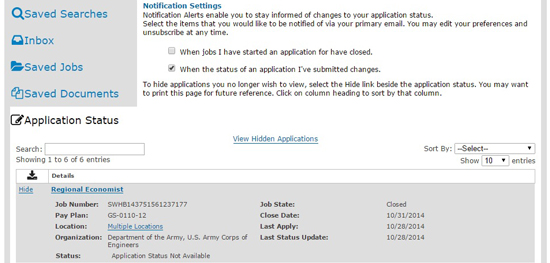
The final steps in the federal hiring process include evaluation, interview, and selection. Applicants may set their preferences in USAJOBS so that they receive automated email notifications at the end of each step. You may also check your application status online at any time.
After you accept a job offer, your federal career starts with orientation and an oath of office. Congratulations!
The federal government has workers in about 350 different occupations, according to the U.S. Bureau of Labor Statistics. For detailed information about those and more occupations, see the Occupational Outlook Handbook (OOH). Each OOH profile includes information about job duties, employment, wages, qualifications, and job outlook.
Visit USAJOBS to find vacancy announcements and apply for federal jobs.
To learn more about working for the federal government, visit the OPM website. OPM provides information about federal employment, including hiring practices and workforce data.
Visit Go Government for information on a variety of topics related to federal employment, such as application tips and the pros and cons of government work.
“The Best Places to Work” scores and ranks each federal agency. You can compare up to three agencies in a number of categories, including leadership, worklife balance, and employee demographics.
“Working for the federal government: Part 1,” published in Career Outlook in September, covers frequently asked questions about working for the government, employment details, and the rewards and challenges of federal work.
The federal government has a number of employment programs to attract candidates with specific backgrounds and skills. Called hiring authorities, these shortcuts to government employment may simplify the application process.
The Pathways Programs are three employment programs, each with its own eligibility requirements and rules. Participants who successfully complete a program may be transitioned into a permanent position.
Internships Program. This program offers current students—from high school through the graduate level—full- and part-time employment. Agencies may hire interns for up to 1 year, or until students complete their educational requirements.
Recent Graduates Program. People who have completed a qualifying certificate or degree from an accredited school within the previous 2 years may apply to available positions through this program. Qualifying degrees include vocational, associate’s, bachelor’s, master’s, and professional degrees. This program lasts 1 to 2 years and includes mentorship and formal training.
Presidential Management Fellows Program. This program is open to candidates who have completed an advanced degree, such as a master’s or professional degree, within the previous 2 years. After an assessment period, finalists apply to available positions, with each agency vying for the top candidates. Fellows work for 2 years in an excepted service position and receive senior-level mentorship and formal training.
Veterans, military spouses, and Peace Corps and AmeriCorps volunteers may have more options to be considered for federal jobs than the typical applicant does, as described below.

Veterans. Military veterans may be eligible for Veterans’ Preference, which assigns points toward their consideration for a federal job. To qualify, veterans must have an honorable or general discharge from active duty lasting more than 180 days. Veterans who have a service-related disability or were awarded a Purple Heart may receive additional points.
In addition, veterans may qualify for a few other special hiring authorities. For example, the Veterans’ Recruitment Appointment allows agencies to hire, outside the usual hiring (called “competitive”) process, eligible veterans to an excepted service position up to GS-11.
Military spouses. Eligible military spouses who relocate because of their husband’s or wife’s active-duty assignment may receive eligibility for federal vacancies outside the competitive process.
Volunteers. Peace Corps and AmeriCorps VISTA volunteers who successfully complete their service may have 1 year of eligibility outside the competitive process in applying for federal jobs.
Some applicants, agencies, and positions are in the “excepted service” and follow different hiring procedures than those of the U.S. Office of Personnel Management.
Disabilities. Applicants who have a disability may be able to seek appointment outside the competitive process to a position for which they are qualified. To be eligible, candidates must have a severe physical, cognitive, or emotional disability and must submit a certification letter from their State Vocational Rehabilitation Office. After 2 years, workers may qualify for a permanent appointment in the same position.
Other excepted service. Excepted service agencies and departments include the U.S. Department of State, the United States Supreme Court, and the Library of Congress. Other agencies may have excepted service positions that require in-demand skills in critical occupations, such as lawyers. Vacancy announcements for excepted service agencies, departments, and positions are often available directly from the hiring agency’s website, rather than through USAJOBS.
Dennis Vilorio, "Working for the federal government: Part 2," Career Outlook, U.S. Bureau of Labor Statistics, November 2014.